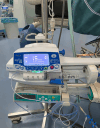Ketofol (Ketamine-Propofol) in Pediatric Awake Neurosurgery: An Anesthetic Perspective
- PMID: 41030487
- PMCID: PMC12479080
- DOI: 10.14740/jmc5178
Ketofol (Ketamine-Propofol) in Pediatric Awake Neurosurgery: An Anesthetic Perspective
Abstract
Awake neurosurgical procedures for brain tumor resections are uncommon in the pediatric population, and careful consideration is required regarding the patient's cognitive maturity, emotional readiness, and ability to cooperate throughout the intraoperative mapping process. The functional significance of the tumor location may demand precise neurological monitoring, while minimizing sedation to maintain patient responsiveness during cortical stimulation and language testing. We present the case of a 14-year-old patient who was diagnosed with a left temporal lobe tumor. Neuroimaging revealed a lesion with radiological characteristics and clinical correlation highly suggestive of a low-grade glioma. The tumor was situated within the dominant hemisphere, near eloquent cortical regions critically involved in language processing and memory function. These anatomical considerations posed a significant challenge to achieving maximal resection while minimizing the risk of neurological deficits. After thorough multidisciplinary discussion, the neurosurgical team opted for an awake craniotomy. This approach was chosen to facilitate intraoperative cortical and subcortical functional mapping, allowing real-time monitoring of language and cognitive functions. The primary objective was to achieve the greatest possible extent of safe tumor resection while preserving essential neurological functions and ensuring the patient's long-term quality of life. Anesthetic management of this patient was particularly challenging, as intraoperative seizures were a major concern due to both the tumor's cortical irritability and the stimulation required for functional mapping. We administered a combination of propofol and ketamine (ketofol) to provide monitored anesthesia care during the procedure. Preoperative planning included seizure prophylaxis, clear communication with the neurosurgical and neuropsychology teams, and the development of contingency strategies for airway management in the event that conversion to general anesthesia became necessary. This case underscores the complexity of pediatric awake craniotomy and highlights the importance of a multidisciplinary, individualized approach to optimize patient safety and surgical outcomes.
Keywords: Awake neurosurgery; Ketamine; Pediatric neuroanesthesia.
Copyright 2025 Authors.
Conflict of interest statement
None to declare.
Figures





References
Publication types
LinkOut - more resources
Full Text Sources
